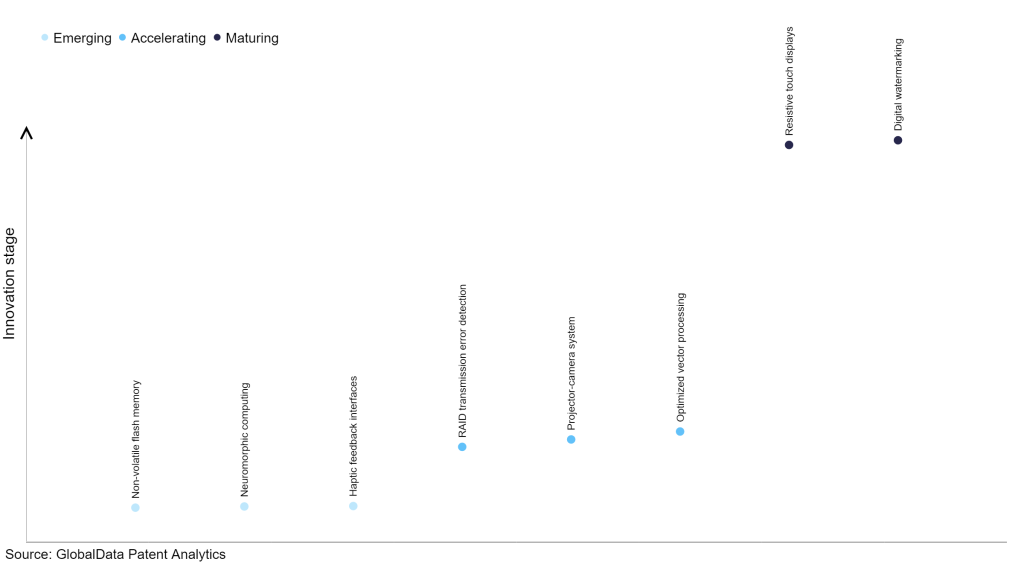The technology industry continues to be a hotbed of innovation, with activity driven by the increasing demand for high-resolution displays, immersive gaming experiences, and advanced visual effects and the growing importance of technologies such as advanced shader architectures, real-time ray tracing, deep learning-based image processing, and efficient memory management. These technologies continuously evolve to meet the increasing demands for realistic graphics and improved visual experiences in various applications. In the last three years alone, there have been over 1.5 million patents filed and granted in the technology industry, according to GlobalData’s report on Technology Innovation: Graphics controllers. Buy the report here.
However, not all innovations are equal and nor do they follow a constant upward trend. Instead, their evolution takes the form of an S-shaped curve that reflects their typical lifecycle from early emergence to accelerating adoption, before finally stabilising and reaching maturity.
Identifying where a particular innovation is on this journey, especially those that are in the emerging and accelerating stages, is essential for understanding their current level of adoption and the likely future trajectory and impact they will have.
185+ innovations will shape the technology industry
According to GlobalData’s Technology Foresights, which plots the S-curve for the technology industry using innovation intensity models built on over 1.6 million patents, there are 185+ innovation areas that will shape the future of the industry.
Within the emerging innovation stage, non-volatile flash memory, neuromorphic computing, and haptic feedback interfaces are disruptive technologies that are in the early stages of application and should be tracked closely. RAID transmission error detection, projector-camera system, and optimized vector processing are some of the accelerating innovation areas, where adoption has been steadily increasing. Among maturing innovation areas are resistive touch displays and digital watermarking, which are now well established in the industry.
Innovation S-curve for the technology industry

Graphics controllers is a key innovation area in technology
Graphics controllers are essential hardware components that oversee the display and processing of graphics in a computer system. Their primary function is to transform input data into visual representations displayed on computer monitors or other output devices. Graphics controllers can be found in various devices, such as laptops, desktops, and gaming consoles, ensuring smooth and accurate rendering of graphical content.
GlobalData’s analysis also uncovers the companies at the forefront of each innovation area and assesses the potential reach and impact of their patenting activity across different applications and geographies. According to GlobalData, there are 60+ companies, spanning technology vendors, established technology companies, and up-and-coming start-ups engaged in the development and application of graphics controllers.
Key players in graphics controllers – a disruptive innovation in the technology industry
‘Application diversity’ measures the number of different applications identified for each relevant patent and broadly splits companies into either ‘niche’ or ‘diversified’ innovators.
‘Geographic reach’ refers to the number of different countries each relevant patent is registered in and reflects the breadth of geographic application intended, ranging from ‘global’ to ‘local’.
Patent volumes related to graphics controllers
Source: GlobalData Patent Analytics
Advanced Micro Devices is one of the leading patent filer in graphic controllers. The company’s patents are aimed at invention describing a graphics multi-media integrated circuit (GMIC) is connected to a host processor over two serial links: a half-duplex bi-directional serial link which accords to a protocol defined for a display serial interface, and a uni-directional serial link which accords to a compatible protocol defined for a camera serial interface. The GMIC receives packets according to the protocol from the host over the half duplex bi-directional serial link and processes these packets. The GMIC sends packets according to the protocol to the host over the uni-directional serial link. A packet from the host can request a processing operation by the GMIC or can initiate a memory operation at the memory of the GMIC.
The GMIC can also send packets to the host to initiate a memory operation at the memory of the host. The GMIC may be connected to a display over a bi-directional serial link according to the display serial interface protocol and to a camera over a uni-directional serial link and a bi-directional control link according to the camera serial interface so that the host controls the display and camera indirectly through the GMIC. The other prominent patent filers in the space include Intel and Apple.
By geographic reach, OTOY leads the pack, followed by Fujifilm and Safran. In terms of application diversity, Apple holds the top position, followed by Intel and Advanced Micro Devices.
Graphics controllers are specialised hardware components that handle the rendering and display of visual content on electronic devices. They are responsible for processing and manipulating graphical data to generate images, videos, and animations with high-quality graphics and smooth performance. Graphics controllers play a crucial role in various industries, including gaming, multimedia, virtual reality, and professional graphics applications.
To further understand the key themes and technologies disrupting the technology industry, access GlobalData’s latest thematic research report on Technology.
Data Insights
From

The gold standard of business intelligence.
Blending expert knowledge with cutting-edge technology, GlobalData’s unrivalled proprietary data will enable you to decode what’s happening in your market. You can make better informed decisions and gain a future-proof advantage over your competitors.







